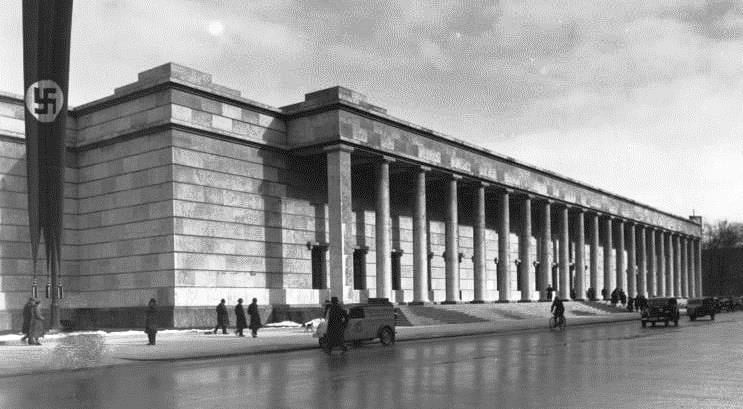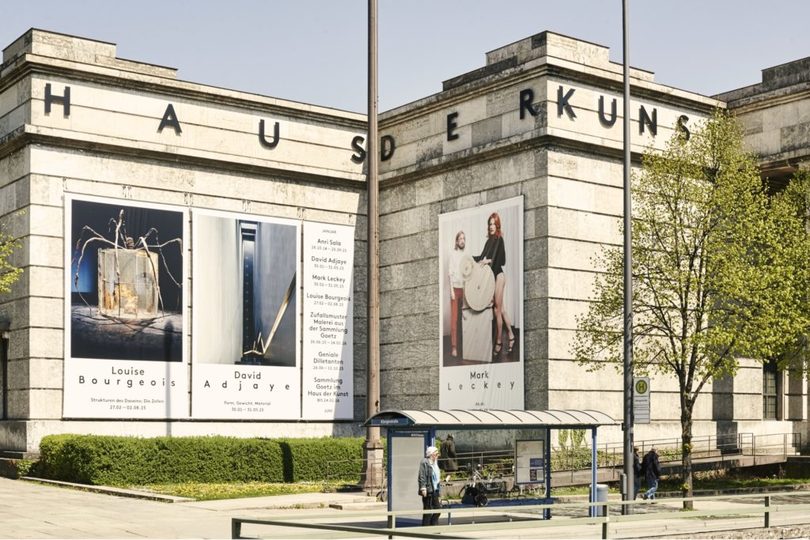Art World
Debate on David Chipperfield’s Plan for Haus der Kunst’s Facade Intensifies
Trees currently obfuscate the monumental front.

Trees currently obfuscate the monumental front.

Hili Perlson

A renovation plan for Munich’s Haus der Kunst museum, devised by star architect David Chipperfield, has sparked outrage from politicians, Munich residents, and Jewish groups since it was first made public in December 2016, due to its de facto return of the museum’s outside appearance to its World-War-II-era fascist design. Now, city officials have rejected the plan for the monumental building’s 175-meter long façade, asking Chipperfield to defend his design at a debate with the Bavarian Parliament’s art committee.
Opened by Adolf Hitler in 1937, the museum was originally named “House of German Art” and was dedicated to promoting the National Socialist’s views on what art should be, becoming symbolic of the persecution of so-called “degenerate” artists in Nazi Germany.
Through the years, the museum—which has been helmed by director Okwui Enwezor since 2011, and by Chris Dercon before him—has made a concerted effort to address and challenge its sinister past with a diverse and multifaceted program and has established itself as one of the most important institutions in Germany. Chipperfield’s renovation plan has been denounced as a step backwards from the progress that the museum has made.
According to the Tagesspiegel, the British architect presented his arguments to local politicians last week, claiming that 98 percent of the renovation project—and its €78 million ($83.7 million) budget—have to do with the museum’s interior, and include optimizing the building’s energy consumption, updating its temperature regulation systems, and bringing its safety requirements up to standard.

David Chipperfield. Photo by Bruno Cordioli, Creative Commons Creative Commons Attribution-Share Alike 3.0 Germany license, Bundesarchiv, Bild 146-1990-073-26 / CC-BY-SA 3.0.
These as well as other arguments were met with approval, especially Chipperfield’s suggestion to rethink the museum’s underused west wing and transform it into a stage for performances, concerts, and discussions. His plan to open up the entrance to the English Garden outside the museum, which has been blocked by a drab parking lot, was also widely accepted.
But things turned more tense when the architect discussed the refurbishments of the exterior. “What we have planned has nothing to do with the trees,” he said, referring to the rows of trees that now embellish the view of the building’s front and which were meant to be felled as part of the redesign. He added that the decision of whether or not to keep the trees has a “philosophical aspect” to it.
Bavarian culture minister Ludwig Spaenle agreed with Chipperfield, saying that the removal of the “green curtain” could raise questions such as “How do you deal with historicality?” The minister is now calling for a debate on the museum’s appearance, saying he wishes to “initiate democratic discourse.”

The Haus der Kunst, Munich. Photo by Dan Wojcik, courtesy of Haus der Kunst.
Green party politician Sepp Dürr, never one to mince his words, argued that if the building returned to its WWII-era appearance, the question becomes not a philosophical one, as Chipperfield argued, but a political one.
The city is now looking for new solutions regarding how to deal with the exterior. What’s certain is that Chipperfield’s plan to restore the exterior of the building and the surrounding grounds to the original state is off the table.
Meanwhile, Chipperfield may have come to accept the linden trees obfuscating the façade. “If we keep them,” he said, “we should celebrate them.”